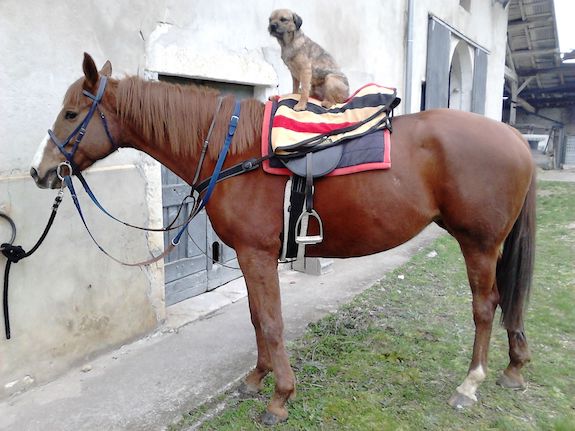
Withers, hocks, sock, stocking, different gaits, crest, feathers, conformation, muzzle, pastern……….these are among the terms we’ve gotten from the horse world. Old-timers, both owners and breeders, developed jargon that provided clarity and precision in defining the attributes, faults, and overall descriptions of their horses, and with few changes, this carried over to how we describe dogs.
Our understanding of dog structure and movement also comes from the horse world. A straight front in a horse, for example, means a bumpy ride for the rider since the horse is unable to extend its front to cover ground effortlessly, but it has to work twice as hard to keep up with horses with better angulation.
We got curious.
Many of our breeds were also developed to work in conjunction with equines, but interestingly, few breed standards mention this. Especially surprising is that the breed most associated with horses, the Dalmatian, never mentions the word, “horse,” but rather that “…in keeping with the Dalmatian’s historical use as a coach dog, gait and endurance are of great importance.”
The only other mention of “horse” in a breed from the Non-Sporting group has to do with the coat of the Shar-Pei: “Acceptable coat lengths may range from extremely short “horse coat” up to the “brush coat…”
The Entlebucher Mountain Dog breed standard reads, “Their keen intelligence, speed and agility also made them useful for the management of other large animals such as horses and hogs.”
The Sheltie’s breed standard writes that the breed “now bears the same relationship in size and general appearance to the Rough Collie as the Shetland Pony does to some of the larger breeds of horses.”
We were about to write that we were surprised that horses didn’t appear in any hound standard, given that foxhounds have to navigate around horses during a fox hunt, but the Basenji standard kept us from being able to say that: “The Basenji should not bark but is not mute. The wrinkled forehead, tightly curled tail and swift, effortless gait (resembling a racehorse trotting full out).”
The one breed standard that actually mentions horses in a way we would expect belongs to the Border Terrier. “[This] is a working terrier of a size to go to ground and able, within reason, to follow a horse, his conformation should be such that he be ideally built to do his job.”
Breed standards are endlessly curious to read, particularly when contrasted to other breed standards, but especially when compared to earlier versions of themselves.
Image: Found unattributed on Pinterest and happily credited upon receipt of information

Hello. That is CH Stonechester Question VON Jrasamuyr Master of Foxhound certificated. Sitting aboard Shochana a retired racehorse. All my Border Terriers are riders and are raised around horses. They all work and hunt. Plus have show accreditation, Keeping Border Terriers how they were bred,.